Your first few experiences with food in Japan will probably be the usual: sushi, ramen, udon. But when you want to dig a little deeper, it's time for Osaka soul food. Okonomiyaki.
With a history as rich as its flavor, Japan's "pancake/pizza/crepe/omelette" will fill you up and ensure you come back for more.
What is Okonomiyaki?
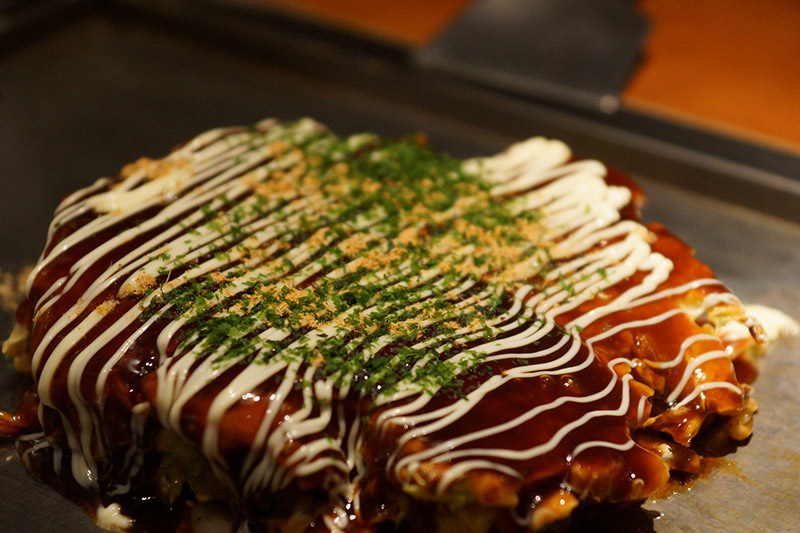
Okonomiyaki is described many ways. "Crepe" and "omelette" are two common comparisons. But you're bound to hear "Japanese pizza" or "Japanese pancake" most often. These monikers are all true to an extent but basically wrong.
Okonomiyaki is a flour based mixture cooked on a griddle. Thus a cake from a pan, or "pancake." But it doesn't have the sweetness of fluffiness the name connotes (at least in the American sense).
Its pizzaness comes from the various ingredients. Just like you can have whatever you want on your pizza, you can have whatever you want on (or in) your okonomiyaki.
In fact, the name okonomiyaki お好み焼き means "whatever you like grilled." The first part of the word okonomi お好み means "choice" or "preference." If you use the word konomi 好み in a sentence, it can mean "one's type." As in "He is my type." The second part, yaki 焼き means "cooking," "frying," or "heating." It's the same yaki in teriyaki, yakisoba, and yakiniku.
As the name insists, you can do what you like. But there are some differences in ingredients that change the style of the dish depending on the region of Japan.
The two main styles are Osaka (or Kansai) style and Hiroshima style.
Osaka Style
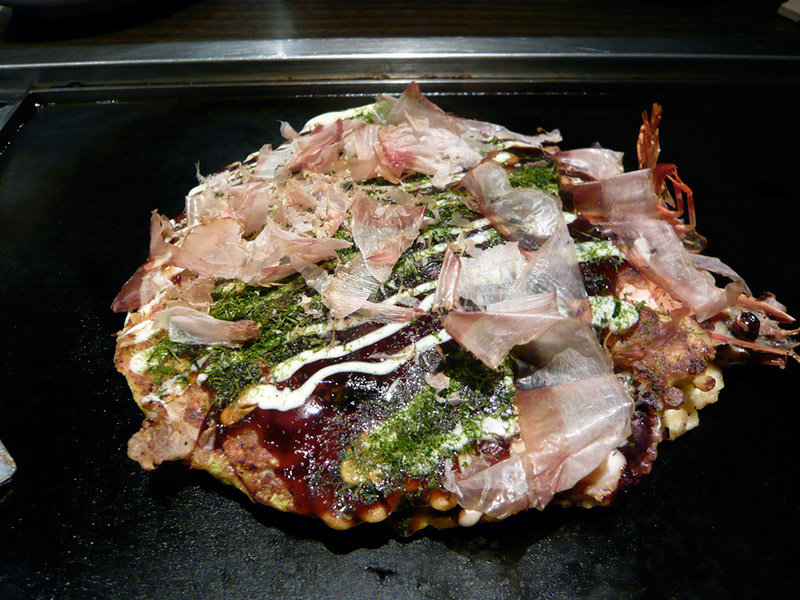
Because you can add "whatever you like" the possibilities are endless. But there are certain ingredients which must be present before you can start adding things to the batter. Here are the essentials that make up Osaka style okonomiyaki.
The Flour
- Tenkasu: Little bits of batter that fall into oil when frying tempura.
- Beni shouga: Little red sour pickle slivers. Gives a sour kick.
- Dashi stock: A soup stock containing our umami friend katsuobushi. If the name is unfamiliar, chances are you've eaten it (and loved it). Read our article that explains everything about katsuobushi.
- Eggs and Flour: You know what these are.
- Cabbage: Arguably the "main" ingredient. Each pancake is packed with leafy goodness. All the fiber adds a healthy touch. You don't want to use North American cabbage though. It's a bit hard. If you're in North America, look for cabbage labelled, "Asian cabbage" or "Taiwanese cabbage."
The Toppings
- Aonori: A green seaweed shredded into near powder form and used as a topping.
- Dried Bonito Flakes: This also come from our friend katsuobushi. This super umami topping is used in a lot of Japanese dishes, but it is absolutely necessary here. The flakes "dance" in the heat.
- Okonomiyaki sauce: A topping so essential it bears the name of the dish. A dark brown sauce combining Worcestershire sauce, soy sauce, ketchup, and a dash of sugar or a teaspoon of honey. The dominant sauce brand is Otafuku.
- Japanese mayonnaise: Not just any mayo will do. You need the Japanese kind which is thicker and sweeter than American varieties. Kewpie is the most popular brand.
- Thin sliced pork belly: Any cut of uncooked pork is fine, but the belly is the fattiest (and tastiest) part. Fat and flour is a great combination. It's put on one side of the okonomiyaki and fried into the pancake. It can be in long strips or smaller pieces. Ground pork may be used instead, but this is more old fashioned.
Okonomiyaki is a special part of the culture in the Kansai region of Japan. So much so, that they think of it in special ways. Even though it is packed full of carbs, citizens of Kansai consider it okazu 御数. Okazu is a dish that goes with rice. In this case, carbs with carbs. People from other parts of Japan think this is weird.
Besides "okazu," another special label for okonomiyaki is "konamon." In Osaka and the Kansai region, foods made with flour are called konamon 粉モン. Kona 粉 means powder and "mon" is "mono" ("stuff" or "things") in the Kansai dialect. Thus okonomiyaki is considered "konamon" in Osaka.
Osaka style may also be referred to as "Kansai style" in parts of Kansai. But the main difference in this sub-style is the mayonnaise. Osaka style always has mayonnaise as a topping. But other cities in Kansai such as Kobe or Hyogo likely will not.
Hiroshima Style
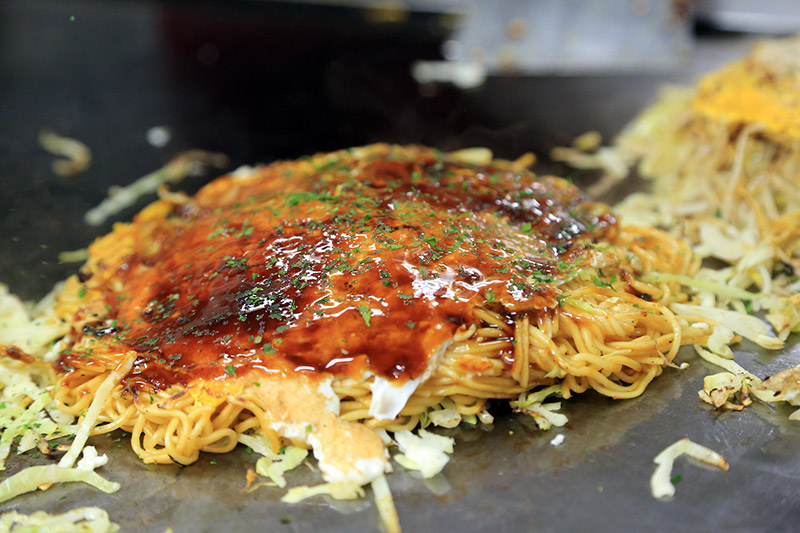
If you saunter into Hiroshima and try to cook up some Osaka style okonomiyaki, a local is likely to approach your griddle and say, "We don't take kindly to that kinda cookin' in these parts."
Actually, that wouldn't happen. Hiroshima people are really nice (though there are definitely a lot of yakuza there). They would probably just make you some of their signature okonomiyaki with a big smile. Don't ask for "Hiroshima style" in Hiroshima though. Just ask for okonomiyaki. Asking for "Hiroshima style" implies their style is not the main and truest style of the dish in existence. And you don't wanna do that.
What sets Hiroshima style apart? The ingredients are mostly the same as the Osaka style. The most noticeable difference is the noodles. Hiroshima okonomiyaki is topped with yakisoba or udon noodles and a fried egg. The soba noodles are much more common though. Instead of mixing ingredients into the batter, they are layered. And there's a heck of a lot more cabbage too, up to four times as much as the Osaka variety. The cabbage is piled on top. As it cooks down, it's flattened and more cabbage is added. Beansprouts are also a signature Hiroshima ingredient. The most noticeable difference flavor-wise is the sauce. Hiroshima style sauce is sweet, whereas Osaka sauce is a tad spicy.
Okonomiyaki History
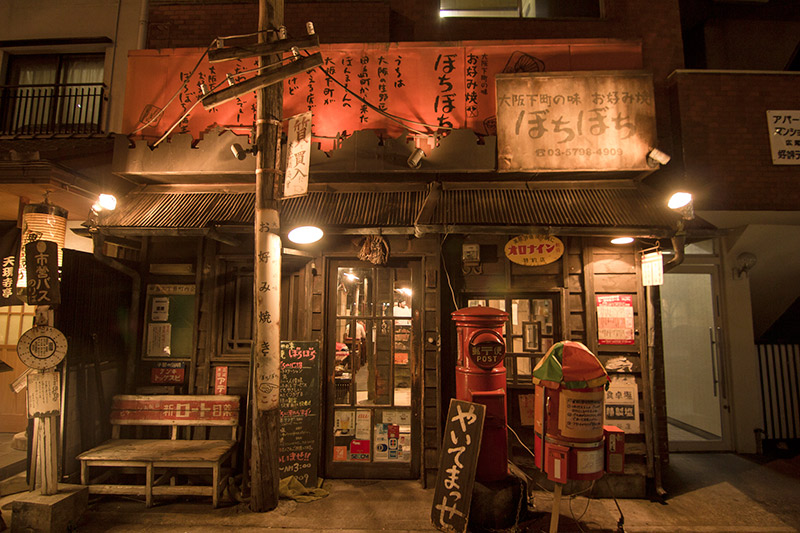
The origin of okonomiyaki can be traced back to the Azuchi-Momoyama period (1573-1603). At that time, a man well-known for impacting tea ceremony named Sen no Rikyu is credited with creating something called funoyaki 麸の焼き, also known as fuyaki 麩焼き. People in northern Shiga prefecture call it "funayaki" in their dialect.
This dish is made of wheat dough which is rolled thin, toasted, and topped with poppy seeds, Japanese pepper miso paste, and sugar. Because the rolled shape looks like a sutra scroll, it was served at Buddhist ceremonies in autumn. In a way, it's like the Japanese crepe.
Sukesouyaki Origins (And a Myth Dispelled)
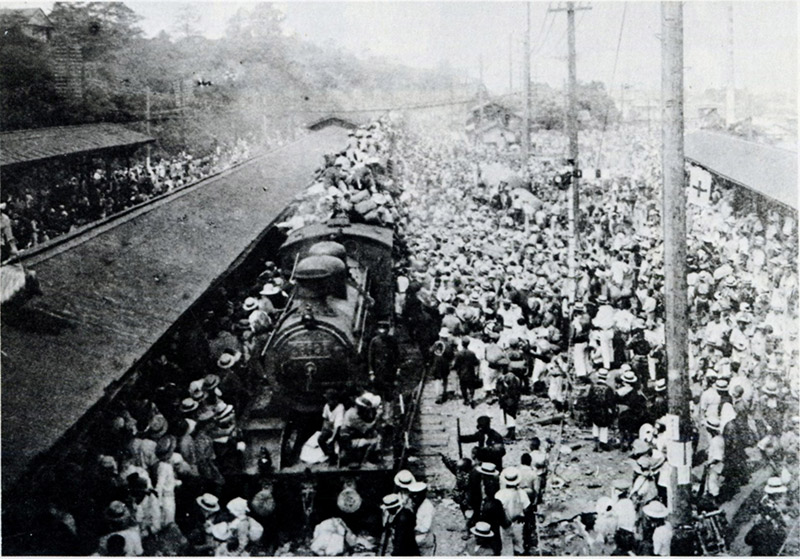
From the Edo period to the Meiji period, funoyaki evolved. Sweet bean paste called nerian 練餡 replaced the miso paste at the end of Edo period. The sweet treat got even sweeter and was called sukesouyaki 助惚焼.
There's actually a bit of a myth involved in the funoyaki/sukesouyaki evolution. It was started by food researcher Tekishū Motoyama 本山荻舟 in an article on okonomiyaki in the Heibonsha 1964 encyclopedia vol.3 p.455. There were two snacks during the Edo period, gintsuba 銀鍔 in Kansai, and kintsuba 金鍔 in Edo. The myth says sukesouyaki was a popular variant of the Edo variety. A variant of a variant, if you will.
But this is dubious.
There are no sources in Japanese to support this theory besides the one Motoyama wrote himself. This theory has been spread around English sources thanks to Wikipedia citing it.
Here's the real story behind gintsuba/kintsuba:
In the Tenna/Tenwa-nenkan 天和年間 era of the Edo period (1681-1684), "gintsuba" was created in Kyoto, around the Kiyomizu temple area. It quickly spread to the surrounding Kansai area. The dough was made from non-glutinous rice flour, top-grade stuff.
The recipe made its way to Edo during the Kyoho 享保 era of the Edo period (1716-1736). The ingredients changed from top-grade rice flour to ordinary wheat flour. Though the main ingredient was downgraded, the name was upgraded from "gintsuba" meaning "silver sword guard" to "kintsuba" meaning "gold sword guard," because gold sounded fancier. Kintsuba got popular in the Bunka/Bunsei 文化/文政 era of the Edo period (1804-1830). It's still sold in Japan to this day. But it did not spawn any variants, thus it did not spawn sukesouyaki.
Sukesouyaki was created in the same place and period as kintsuba, but about 100 years earlier. Sukesouyaki was made in the Kanei 寛永 era of Edo period (1624-1645) by Sajibei Ookimoto 大木元佐治兵衛. The hikifuda 引札 (announcement flier) he made to introduce sukesouyaki is on display at the Bank of Japan Currency Museum ( kahei-hakubutsukan 貨幣博物館 ).
There we go. Myth busted. Funoyaki spawned sukesouyaki, and there was nothing in between. Onward ho!
In the Meiji period (1868-1912), the sweet sukesouyaki spawned two new savory dishes, monjayaki もんじゃ焼き and dondonyaki どんどん焼き. Both were created in Tokyo.
Monjayaki (often called "monja") is a type of Japanese pan-fried batter with various ingredients. It's similar to okonomiyaki but its batter is more liquid. It was only made in restaurants. Eventually, a portable street food variety was created called dondonyaki.
Dondonyaki is also made of pan-fried batter. But it's solid and rolled up on a stick. It was sold at festivals, during which the sounds of taiko 太鼓 drums filled the air. The sound of taiko in Japanese is "don-don-don." So it was given the catchy name, "dondonyaki." It's still sold at a festivals today and there is also a fried variety.
Monjayaki/dondonyaki went from sometimes food to staple meal after the Great Kanto Earthquake of 1923 caused a food shortage in the Tokyo area. The dish's ubiquity in Tokyo caused it to move down to Osaka, Hiroshima, and Kobe. People there removed the stick, making the portable dondonyaki stationary. They flattened it out and added green onion. Because it was covered in Worcestershire sauce, it was called issen-youshoku 一銭洋食 (cheap Western food) to advertise how affordable it was. Around that time, if you poured Worcestershire sauce on any kind of food, it was considered Western food.
Eventually a variant of issen-youshoku called betayaki ベタ焼き was created in Kyoto. This dish added ingredients like beans, konnyaku, and soy sauce. Another similar dish called choboyaki チョボ焼き was cooked up around this time. Since choboyaki uses a pan with half rounded dents, it's considered to be the origin of takoyaki. In Kansai dialect, "beta" means "flat" and "chobo" means "small rounded thing." Sometimes, all three names, issen-youshoku, betayaki, and choboyaki, are used interchangeably. To further mix things up, these dishes were also sometimes called issen-yaki 一銭焼き or issen-teishoku 一銭定食.
This issen-youshoku revolution continued to swirl around Kansai until the end of the Taisho period (1912-1926). In Kobe the issen-youshoku idea evolved into nikuten にくてん, which is close to the current okonomiyaki (though not quite there). Nikuten tops flour batter with a ton of ingredients and fries it in a pan. The ingredients used differ between regions. The original Kobe recipe uses beef tendon and konnyaku.
The origin of the name "nikuten" in unclear. The first part, niku 肉, is "meat." But there are three theories surrounding the ten てん part of the word. One says it's from "tenkasu" (tempura bits), which are an ingredient. The second says it come from the kanji 転 (flip), because you flip the batter on a pan. Finally, the てん could come from tempura てんぷら because nikuten uses a lot of oil, like tempura does.
Post-War Evolution

After Japan's defeat in World War II, food was scarce. And that meant starvation. There were monthly food rations set up by occupation authorities and the government. But distribution was chaotic. Extra flour was added to rations to make up for the lack of rice. (This is why flour is sometimes called meriken-ko メリケン粉 in Japan. "Meriken" came from "American" and ko 粉 meaning powder.) This gave issen-youshoku and other flour dishes a big boost in popularity.
Though issen-youshoku began life as a children's snack, it became a cheap, filling meal for postwar people living in Kansai. But this meant more changes to the recipe. In Hiroshima, bean sprouts were added. But cabbage was the game changer. Cabbage was added to issen-youshoku to make the dish more filling. The leafy green had become popular in Japan around 1904. Even though it's a winter vegetable, it was cheap year round. It was usually fried or put in soup at home, and its staple status made it a no-brainer when people started adding to their homemade issen-youshoku.
But it didn't end with cabbage. With little to eat, people started adding whatever ingredients they had available to make the meal more nutritious. Eventually this led to the name "konomiyaki" (which is "whatever you like grilled" as I mentioned earlier). The honorific "o" was eventually added to make the name more polite. And finally we have "okonomiyaki." For all intents and purposes, we have arrived at the modern incarnation of the dish.
If you're wondering when egg was added, actually historians aren't sure. Eggs were expensive before and after WWII, so it's safe to say they weren't part of konomiyaki until the post-war period.
In Hiroshima, the issen-youshoku took a similar turn. When American forces distributed flour around 1950, people there added more green onion to issen-youshoku. But it wasn't very filling. So bulky cabbage was added, as was done in the rest of the country. But Hiroshima went the extra mile, throwing noodles into the mix, making Hiroshimayaki distinct from similarly evolving dishes elsewhere.
Meat was hard to come by after the war. Beef had been mainstream during the Meiji period and amazing dishes like sukiyaki were invented. But the Russo‐Japanese War started in 1904 and put a stop to Japan's enjoyment of beef. It was only given to soldiers and became unavailable in the rest of the country. This pushed pork into the limelight. As WWII wore on, all meat became scarce and didn't reappear until the post-war period. This is when issen-youshoku innovators started adding thin slices of meat to okonomiyaki for an inflated price. It's rumored that dog and cat meat was used as "pork" during Japan's poorest post-war years. It's highly likely considering the scarcity of food and the hunger of the population.
The First Okonomiyaki Restaurant? (Shhh…Don't Tell Osaka)
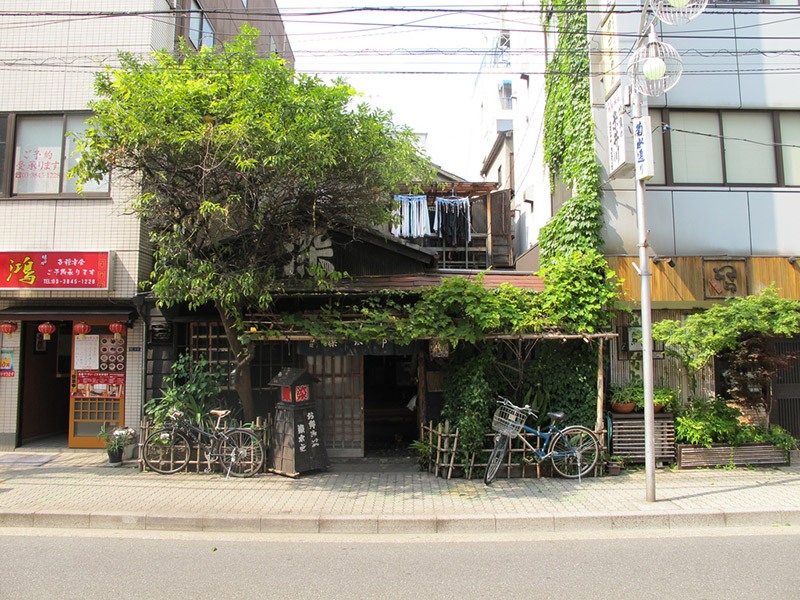
This is all well and good for food made at home. But what about okonomiyaki restaurants? We already talked about Kobe's nikuten, but that was only a step in the evolution. Okonomiyaki was evolving in Kansai, so it has to be in that region, right? Maybe Osaka?
Actually there are two pieces of information that point to the first okonomiyaki restaurant being in Tokyo! And if it's true, it may have been created there as well. Don't tell anyone in Osaka. They'll kill you dead.
-
According to a book called "Takoyaki" written by Mana Kumagai, the first okonomiyaki restaurant was located in small alley in Ginza, Tokyo in the early Showa period. But the restaurant was used as a secret meeting place for people doing things the police didn't like. So the police kept a close eye on this "Ginza Okonomiyaki" shop, effectively squashing the business. This made sure the "okonomiyaki" they invented didn't spread throughout the area. Yeah, right. Highly dubious if you ask me. That's like saying, "I created cars before anyone else, but only me and my friends drove them around and it was a big secret so there's no records, but it totally happened and I invented the car."
-
In the 1939 novel series Ikanaru Hoshino Motoni 如何なる星の下に by Jun Takami, there is a okonomiyaki style restaurant called Horetarou 惚太郎. The fictional restaurant was based on the real restaurant Asakusa Sometarou 浅草染太郎 established in 1937 in Asakusa, Tokyo. So the restaurant predates other restaurants. That doesn't prove they invented the dish. But, in the novel, there is a description of two dishes "ikaten" and "ebiten." Both fit the description of okonomiyaki pretty well. Uh oh. This is one is a bit more plausible.
Osaka's first okonomiyaki restaurant, Botejyu, was established in 1946, which is 9 years after Asakusa Sometarou. Hmmm…if number 2 is true, that's no good for Osaka. It's interesting to think about, but neither of these theories have that much evidence to support them. There's a lot more evidence supporting the idea that okonomiyaki evolved over time. But who knows? Records get lost. Maybe these theories fit into okonomiyaki's evolution somehow.
Osaka Develops Okonomiyaki Culture
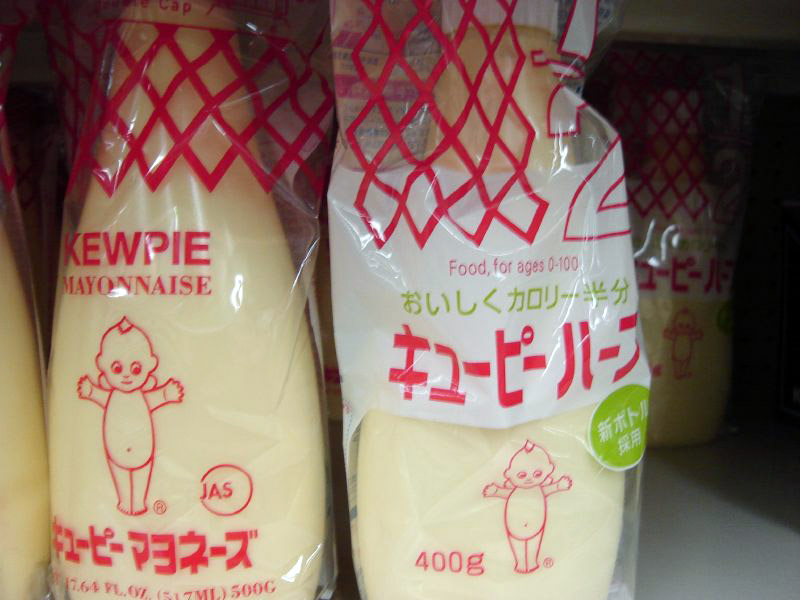
Whether or not okonomiyaki was invented in Osaka, it's definitely the city where it caught on and became part of the culture (besides Hiroshima of course). In 1946, a restaurant called Botejyu was established in Nishinari, Osaka. They served a variety of okonomiyaki such as tontama とん玉 (pork okonomiyaki) and ikatama いか玉 (okonomiyaki). The restaurant eventually got a hold of American mayonnaise from Osaka's black market. They adjusted the taste and introduced the mayonnaise topping to the dish.
In 1957, Botejyu opened a Soemoncho branch in Namba, Osaka. Namba is a well-known "pink district" filled with hostess bars and other night spots. Botejyu's founder invented their iconic spicy mayo which pairs well with alcohol. This made the restaurant even more famous and in 1957, Botejyu was split into "Botejyu Souhonke" (Original Botejyu) and "Osaka Botejyu." Sadly Botejyu Souhonke went bankrupt in 2009. But you can still taste the original recipe at Osaka Botejyu.
After the success of Botejyu, okonomiyaki restaurants became popular all over Osaka. There was at least one in every Osaka town by 1955. It was a common business venture for married couples and widows who lost their husbands during the war. Soon there were 4 or 5 okonomiyaki restaurants in each town. It's said there were even some okonomiyaki restaurants facing each other in some places. Like an Osaka Starbucks, in a way.
Hiroshima Goes its Own Way
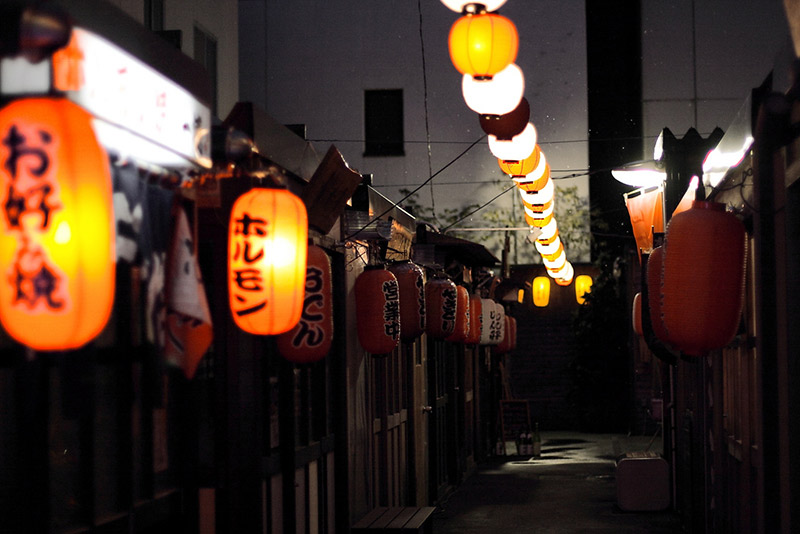
At the same time okonomiyaki was conquering Osaka, it swept across Hiroshima in a big way. The first vendors set up shop in 1950. During this okonomiyaki renaissance, two men, Isao Ise and Zenjiro Nakamura, founded their okonomiyaki empires. They set up their respective establishments in a row of food stalls, which would later be overtaken with okonomiyaki to form "Okonomimura" or okonomiyaki village (more on that later). Ise named his restaurant Micchan みっちゃん and Nakamura named his Zensan ぜんさん. Hot on their heels came Reichan 麗ちゃん and Henkutsuya へんくつや. And all of these restaurants are open today, if you want a taste of history.
If Hiroshima didn't have enough okonomiyaki restaurants, a devastating snow storm in 1963 damaged a lot of farms in the Chuugoku region on Japan. The displaced farmers moved to Hiroshima and opened okonomiyaki restaurants, adding to the Hiroshimayaki saturation.
Up until 1965, you could take your own eggs and meat to an okonomiyaki chef in Hiroshima and they would add it to your meal. Those ingredients were rare during the post-war period and many vendors only offered vegetarian okonomiyaki out of necessity. Hiroshimayaki was just BYOE&M (eggs and meat). It was also BYOP (plate). You could use the restaurant's plates for dine-in, of course. But if you wanted to take your Hiroshimayaki home, you had to bring your own plate. Disposable flatware wasn't an option at that point.
At first, Hiroshimayaki was just layers of veggies and batter, which was served folded in half. Initially green onions were more common in Hiroshimayaki than cabbage, when compared with its Osaka counterpart. After WWII, green onion was replaced with cabbage because the cabbage prices were more stable and reasonable throughout the year.
After the invention of instant ramen in 1958, Hiroshimayaki's signature noodle ingredient joined the mix. Yakisoba was the most popular choice, but sometimes udon was allowed in as well. Since the number of ingredients increased so significantly, Hiroshimayaki became difficult to fold in half. So Hiroshimayaki chefs began serving it flat like its Osaka cousin.
With this, Hiroshima style okonomiyaki was complete.
Rest of Japan, Meet Okonomiyaki
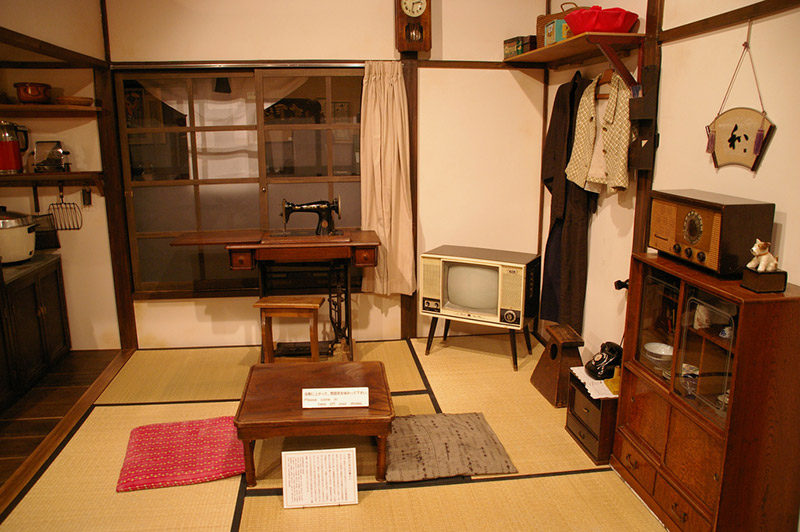
With so much love and dedication put in by the citizens of Hiroshima and Osaka, it wouldn't be long before the rest of Japan wanted a taste. In 1953, Japanese people saw their first television broadcast. If there's one thing true of Japanese TV today, it's that food showcasing is wildly popular. And it was like that from the beginning. Even though TV was black and white until 1960, the broadcast images of okonomiyaki made all of Japan hungry. Popularity spread nationwide. And everyone was happy forever.
Where to Eat Okonomiyaki in Japan
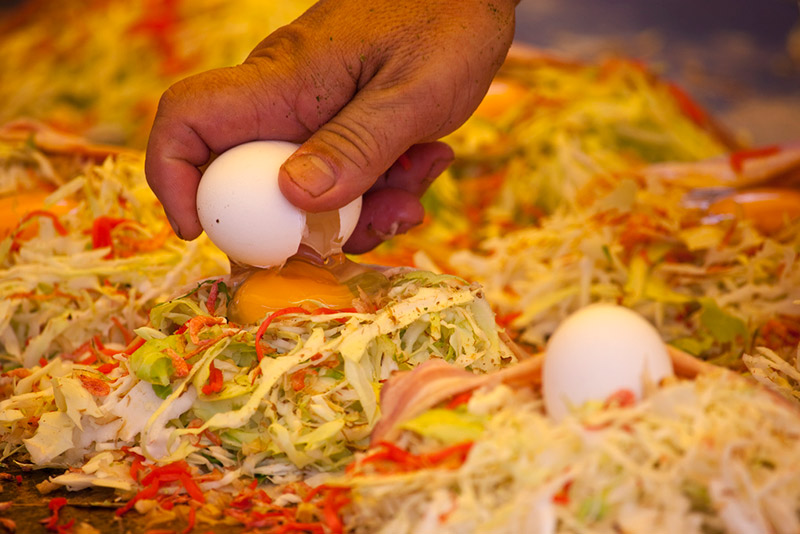
Today, okonomiyaki is all over Japan. There are so many places to choose from. But whether you're visiting or living in Japan, you'll want to get it from the best restaurants possible.
There are two types of okonomiyaki restaurants:
- the kind that let you cook at your table
- the kind that cook it for you
Having chef-prepared okonomiyaki usually means the dish is cooked to perfection. Even if you've made it yourself before, you won't have the spatula skills of a pro chef.
On the other hand, making okonomiyaki at your table is an awesome social experience. Even if the food doesn't come out "perfect," you'll have a great time cooking with your friends.
Below is a list of the best restaurants in Japan that serve what you like grilled.
Osaka
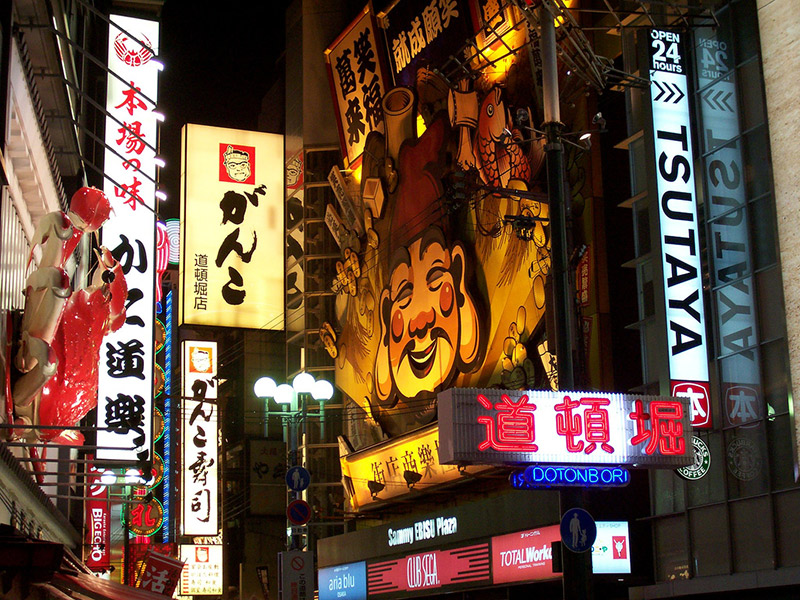
When searching for okonomiyaki, you have to go to Osaka first. It's basically the birthplace of the dish and most definitely the city that does it best (unless you're into the Hiroshima style. Then go to Hiroshima).
Here are the 10 best places to get okonomiyaki in Osaka.
1. Mizuno
The go-to place for okonomiyaki in Osaka is Mizuno. It's the holy grail of these types of restaurants, if you will. There's limited seating, so don't be surprised if you have to wait 30 minutes or more to get in.
The restaurant is located in touristy Dotonbori. But don't let the modern interior design fool you. This is a family run eatery and has been for over 65 years. The original shop was bombed in World War II, but was relocated, rebuilt, and has been thriving to this day.
The English menu caters to visitors, so it's easy to figure out what you're getting even if it's your first okonomiyaki experience.
The chefs cook the okonomiyaki on a griddle at your table. Some people have complained about the rudeness of the wait staff. I can't say I was there for the "rudeness" they encountered, but it's Osaka. The city has a different vibe than the rest of Japan. People used to Tokyo manners may find Osakans "rude."
If you can only try one thing at Mizuno, get their Yamaimoyaki. It's been on the menu since the restaurant opened and is definitely the most popular dish. It's made with Mizuno's signature yam flour, which gives it a smooth texture and sweet flavor. It's topped with roast pork and scallops.
- Address: 1 Chome-4-15 Dōtonbori Chūō-ku, Ōsaka-shi, Ōsaka-fu 542-0071
- Website: www.mizuno-osaka.com
- Telephone: 06-6212-6360
- Hours: Weekdays 11:00 – 22:00
2. Tengu
Have you ever seen "Jiro Dreams of Sushi?" Take the scenario from that documentary, replace sushi with okonomiyaki, make Jiro dead, and that's Tengu.
Tengu is actually two restaurants, one run by a man named Waka and the other by Waka's brother. Waka runs the shop near Nakatsu station and Waka's brother runs the one near Osaka station (see addresses below for more details).
Waka's grandparents started Tengu in 1965. Waka and his brother have been carrying on the tradition ever since, albeit in different locations.
The okonomiyaki at Tengu is made by a master chef and brought to your table piping hot. And this artisan okonomiyaki won't break the bank. Prices can be ¥630, ¥780, or ¥830.
Be prepared to wait. There are only 18 seats at Waka's location.
- Waka's Tengu Address: 3 Chome-15-19 Toyosaki Kita Ward, Osaka, Osaka Prefecture 531-0072 (Near Nakatsu Station)
-
Telephone: 06-6372-7676
- Waka's Brother's Tengu Address: 2 Chome-5-2 Umeda Kita Ward, Osaka, Osaka Prefecture 530-0001 (Near Osaka Station)
- Telephone: 06-6345-6782
3. Kuro-Chan
Founded in 1956, it's also a family business but has maintained the vibe more than Mizuno did. It's a real hole-in-the-wall restaurant and the prices reflect that. Only ¥530 for small okonomiyaki, ¥730 for medium, and ¥950 for large. Eat fast because others are waiting. It only seats 12.
- Address: 2 Chome-14-10 Nakamichi Higashinari-ku, Ōsaka-shi, Ōsaka-fu 537-0025
- Telephone: 06-6972-3841
4. Fukutaro
- Address: 2 Chome-3-17 Sennichimae Chūō-ku, Ōsaka-shi, Ōsaka-fu 542-0074
- Website: www.2951.jp
- Telephone: 06-6634-2951
- Hours: Weekdays 5:00pm – 12:00am / Weekend 12:00pm – 12:00am
5. Kiji (Attached to Umeda Station)
- Address: 9 Kakudachō Kita-ku, Ōsaka-shi, Ōsaka-fu 530-0017
- Telephone: 06-6361-5804
6. Tsuruhashi Fugetsu
- Address: 2-18 Shimoajiharacho Tennoji Ward, Osaka, Osaka Prefecture 543-0025
- Website: www.ideaosaka.co.jp
- Telephone: 06-6771-7938
7. Okonomiyaki Chibo
There are actually tons of Okonomiyaki Chibo locations all over Osaka (and Tokyo and Kanto and China). So check out their store location list DEAD LINK for more.
- Address: 542-0076 Osaka Prefecture, Osaka, Chuo Ward, Nanba, 3 Chome−8−22 EBISUBASHI・ENT B1
- Website: [www.chibo.com] (http://www.chibo.com/)
- Telephone: 06-6634-8181
8. Yukari
- Address: 530-0057 Osaka Prefecture, Osaka, Kita Ward, Sonezaki, 2−14−13
- Website: www.yukarichan.co.jp
- Telephone: 06-6311-0214
9. Ajinoya
- Address: 1 Chome-7-16 Nanba Chūō-ku, Ōsaka-shi, Ōsaka-fu 542-0076
- Phone: 06-6211-0713
10. Negiyaki Yamamoto
- Address: 1 Chome-8-4 Jūsōhonmachi Yodogawa-ku, Ōsaka-shi, Ōsaka-fu 532-0024
- Website: www.negiyaki-yamamoto.com
- Telephone: 06-6308-4625
Hiroshima
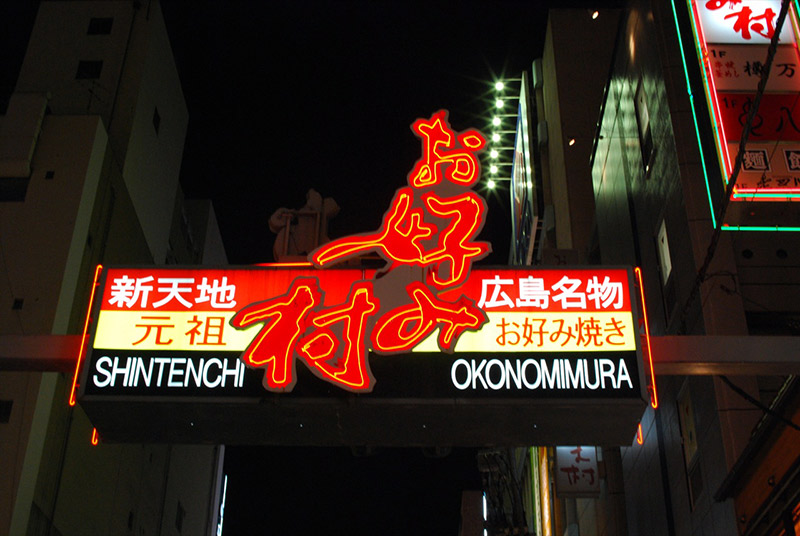
Hiroshima offers so much to visitors. But one of the must-try experiences is the Hiroshimayaki. It's incredibly difficult to make, more so than the Osaka style, so take the opportunity to get it made by a pro when you can. One of these six restaurants will give you that unforgettable experience.
1. Okonomimura
If you only have time to visit one okonomiyaki spot in Hiroshima, make it this one. Imagine a four story mall wherein each shop is a Hiroshimayaki restaurant. Beautiful.
Take your pick of 25 okonomiyaki joints. If one is busy, just go next door. Or up one floor. Or down. It's a loud, boisterous, busy place. Eat here for bustling intensity with your meal. It's a self-described "theme park."
Okonomimura began as a street full of food stalls. The first two okonomiyaki stalls (Micchan and Zensan) did so well, others followed. Though there were other foods available in the area, the majority of stalls served the dish. So much so that writer Minoru Kida said of the place, "It's as if it's an okonomimura (okonomiyaki village)." And the name stuck.
By 1957, there were about 50 stalls. Things were going well for the food vendors on this street until 1965 when the area was turned into a park. Everybody had to leave. The most successful "Micchan," "Reichan," "Zensan," and "Henkutsuya" were popular enough to establish their own brick and mortar restaurants. But other couldn't.
Some gave up, but 14 of them didn't want to quit. They united and decided to create a new Okonomimura in December 1965. And so the official Okonimura was founded. It became a popular destination for school trips coming from all over Japan. The original Okonimura building closed closed in 1990 due to disrepair and safety concerns. So all participating restaurants moved into the current building in 1992.
If you're not hungry when you set out for Okonomimura, you probably will be by the time you get there. If you don't take a taxi from Hiroshima station, it's a 22 minute walk. Good way to burn some calories before you pack them on.
- Address: 5-13 Shintenchi Naka-ku, Hiroshima-shi, Hiroshima-ken 730-0034
- Website: www.okonomimura.jp
2. Micchan
This is the main location, but there's more than one so check the website for the one closest to you.
- Address: 6-7 Hatchōbori Naka-ku, Hiroshima-shi, Hiroshima-ken 730-0013
- Website: www.okonomi.co.jp
- Telephone: 082-221-5438
3. Reichan
- Address: Asse 2-37 Matsubaracho Minami Ward, Hiroshima, Hiroshima Prefecture 732-0822
- Website: www.o-reichan.jp
- Telephone: 082-286-2382
4. Fumichan
- Address: 1-20 Horikawachō Naka-ku, Hiroshima-shi, Hiroshima-ken 730-0033
-
Telephone: 82-542-8777
- Address: 1 Chome-12-4 AsahinMinami-ku, Hiroshima-shi, Hiroshima-ken 734-0036
-
Telephone: 82-250-5007
- Address: 1 Chome-12-4 Asahi Minami-ku, Hiroshima-shi, Hiroshima-ken 734-0036
- Telephone: 82-250-5007
5. Zensan
- Address: 6-24 Nagarekawachō Naka-ku, Hiroshima-shi, Hiroshima-ken 730-0028
- Telephone: 82-877-1058
6. Lopez Okonomiyaki
- Address: 1 Chome-7-13 Kusunokichō Nishi-ku, Hiroshima-shi, Hiroshima-ken 733-0002
- Telephone: 82-232-5277
Tokyo
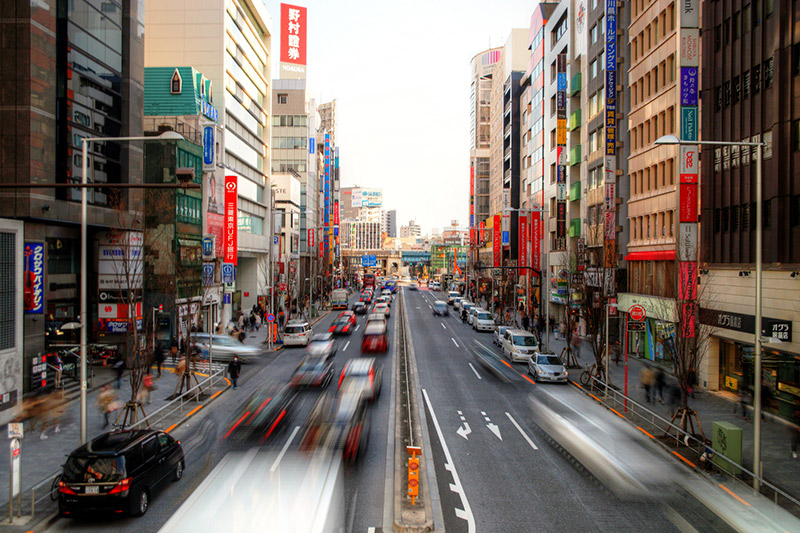
When visiting Japan, chances are you'll be in Tokyo. If you're not able to make it to Osaka, no worries. There's still plenty of okonomiyaki to be had. Tokyo has a little bit of everything.
1. Asakusa Sometaro
This is in a touristy part of Tokyo, so you're bound to be nearby it sometime. There's an English menu for easy ordering (but try speaking some Japanese anyway).
If you remember, this is (possibly) the first okonomiyaki restaurant in Japan. It's a cook-it-yourself place, so go with some friends. If you're having trouble making your pancake, the staff is willing to help. The interior is cozy with tatami seating. That means shoes off and sitting on the floor in front of the griddle (start practicing your seiza). No hurting your wallet here. The most expensive okonomiyaki is only ¥900. Since Tokyo is neutral okonomiyaki territory you can try whichever style you want, Osaka or Hiroshima.
- Address: 2-2-2 Nishiasakusa Taito, Tokyo 111-0035
- Telephone: 03-3844-9502
2. Okonomiyaki Kiji Shinagawa
- Website: www.o-kizi.jp
- Telephone: 03-6712-0256
- Address: 2 Chome-3-13 Kōnan Minato-ku, Tōkyō-to 108-0075 (2nd Floor)
- Address: 1 Chome-4-5 Roppongi Minato-ku, Tōkyō-to 106-0032
- Telephone: 03-6441-3638
- Address: 2 Chome-7-3 Marunouchi Chiyoda-ku, Tōkyō-to 100-0005 (Basement)
- Telephone: 03-3216-3123
3. Ushio
- Address: 3 Chome-10-9 Roppongi Minato-ku, Tōkyō-to 106-0032 (2nd Floor)
- Website: www.ushio.in
- Telephone: 03-5771-8081
4. Chibo
It's our swanky friends Chibo again. Check their website for more Tokyo locations. DEAD LINK
- Address: 〒150-0013 Tōkyō-to, Shibuya-ku, Ebisu, 4 Chome−20−3 (38th Floor)
- Website: www.chibo.com
- Telephone: 03-5424-1011
5. Sakuratei
- Address: 3 Chome-20-1 Jingūmae Shibuya-ku, Tōkyō-to 150-0001
- Website: www.sakuratei.co.jp
- Telephone: 03-3479-0039
Eating Okonomiyaki at Home

If you can't find a restaurant that serves okonomiyaki near you, good news: it's easy to make at home. Well, the Osaka variety is. Hiroshimayaki takes a bit more practice. But it's still possible. Japanese families may have an electric griddle so the can cook together at the dinner table. If you don't have one of those, you can use a frying pan on the stovetop.
Let's check out some ingredients and show you how to make okonomiyaki for dinner tonight.
Tools
1. Spatula: hera へら (in standard Japanese), kote こて (in Kansai dialect), or teko てこ (in Hiroshima dialect)
Today many people in Hiroshima call spatulas "hera," forsaking their native word. If you go to a hardware store, it may be called okoshigane 起し金. In okonomiyaki restaurants, it's called kaeshi 返し meaning "a flipping thing."
You may want two big spatulas to flip the pancake and one small one for cutting into small pieces. In an okonomiyaki restaurant, the big one is called oo-teko 大テコ and the small one is called koteko 小テコ. In the Kansai area, the name for the small one was shortened from "koteko" to "kote" and became part of the local lexicon. If you don't have a small spatula at home, don't worry. Okonomiyaki isn't hard to cut. In fact, Mami always uses chopsticks to cut hers into pieces.
2. Oiling Brush: Abura-biki or Abura-hiki 油引き
Used with oilcan: Abura-tsubo 油壺
"Abura" means oil and "hiku" means to pull or draw. But the verb is also used for "to oil" or "to grease." If you want to say, "please oil the frying pan," the Japanese would be furai-pan ni abura o hiite kudasai フライパンに油を引いて下さい.
"Tsubo" means jar or pot. If you use a big grilling pan, the oiling brush is a necessary. But most people don't bother with it. Many simply use a paper towel (called "kitchen paper" in Japanese English). Surprisingly, some people use tenugui. Good ones suck up the oil better. And the more you use it, the more oil it absorbs making it work better.
3. Bowl: booru ボール
Use any bowl to mix the flour. Any bowl at all. Except a dirty one.
4. Whisk: awadate-ki 泡立て器
Whisks mix best, but some people are so lazy they just use chopsticks, forks, or spoons to mix the batter. Lazy, I say!
5. Flour sieve: kona-furui 粉ふるい
This is to avoid lumps, apparently. Only if you care. About PERFECTION!
6. Measuring cup & measuring spoons: keiryou-kappu or keiryou-supuun 計量カップと計量スプーン
For measuring.
7. Scale: hakari はかり
For scaling.
8. Ladle: otama おたま
For ladling.
9. Kitchen knife: houchou 包丁
For knifing.
10. Electric griddle: hotto pureeto ホットプレート
If you don't mind cooking each okonomiyaki individually, then a frying pan will do just fine. But you definitely need a griddle if you're making the dish with other people. That way you can make multiple pancakes at the same time.
The Necessary Ingredients
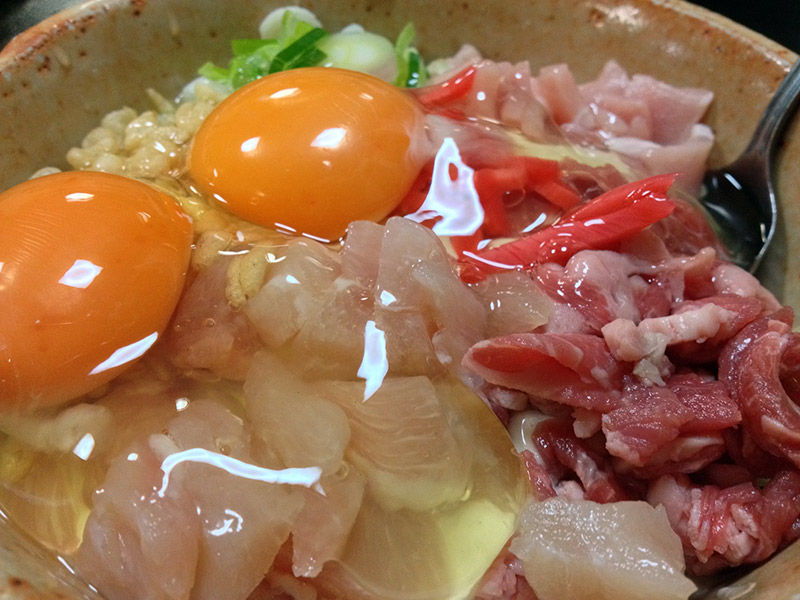
Okonomiyaki-Ko
If you don't want to make your okonomiyaki flour from scratch, go ahead and use the pre-made okonomiyaki-ko. (Remember ko 粉 means powder. Like panko.) When Japanese people have okonomiyaki parties at home, many use store-bought flour, called shihan-no-okonomiyakiko 市販のお好み焼き粉.
If you're not sure what to look for when visiting the Asian grocery nearest you, check the links below. These are the different kinds that may be available.
- Nisshin Okonomiyaki-ko 日清 お好み焼粉: The most common brand
- Nisshin Extra Dashi Okonomiyaki-ko
- Nisshin Extra Yamaimo Okonomiyaki-ko
- Otafuku Okonomiyako-ko オタフク お好み焼き粉: Powder mix by the maker of Japan's top okonomiyaki sauce producer
- Otafuku Soft Okonomiyaki-ko
- Otafuku Hiroshimayaki-ko
- Otafuku Pure Yamaimo Powder One important thing. After you open the okonomiyaki powder, keep leftovers in the fridge. The package may say "store at room temperature," but don't do it. The contents won't spoil, but mites and ticks may decide to burrow in your powder. One Japanese TV show visited 114 houses randomly and found 7 okonomiyaki powder containers had mites and ticks in them.
The powder won't take up much fridge space, so cram it in there. Or just make more okonomiyaki.
Cabbage
Cabbage is the heart of okonomiyaki. The flour just holds the cabbage together. It's the most important ingredient in both Osaka and Hiroshima style.
According to the "Larousse Cooking Encyclopedia," there are over 60 kinds of cabbages. North American cabbage is too hard. If you are outside of Japan, look for an Asian or Taiwanese cabbage. If you are in Japan, look for harutama 春玉 / haru-kyabetsu 春キャベツ (spring cabbage), kantama 寒玉 / fuyu-kyabetsu 冬キャベツ (cold/winter cabbage), marutama 丸玉 / guriin booru グリーンボール (green ball cabbage), or chirimen ちりめんキャベツ / saboi-kyabetsu サボイキャベツ (savory cabbage).
The kantama is the best by far, sweet and crunchy. But it's only available in fall and winter. When choosing a cabbage, look for
- shiny, dark green leaves
- a head that feels heavier than it looks If kantama is unavailable, marutama is fine too. It should be in stores year round. The harutama and chirimen-kyabetsu are a bit too soft, but they're better than nothing.
Osaka Style Okonomiyaki Recipe
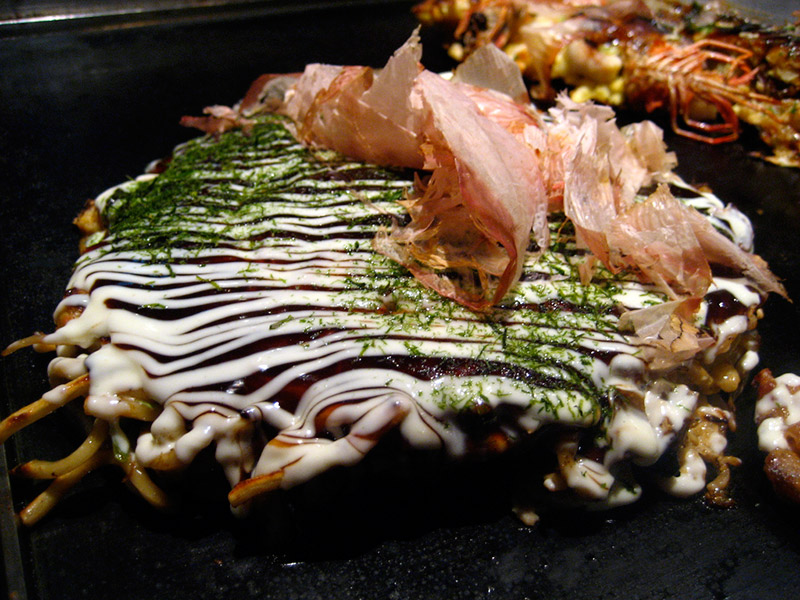
This is a recipe shared by famous Osaka okonomiyaki vendor, Naniwa Nanitaro. Makes one pancake.
Ingredients:
- Okonomiyaki flour mix: If not using a pre-made mix, combine:
- 40g weak flour
- 60cc of dashi-mixed water
- 1/4 teaspoon baking powder
- 1/4 teaspoon salt
- 1/2 teaspoon sugar
- 1 teaspoon yamaimo powder (Instead of yamaimo powder, you can grate actual yamaimo/nagaimo. Use 20g per okonomiyaki. This means more liquid coming from the grated root. So decrease dashi-mixed water from 60cc to 40cc.)
- pork belly and/or squid: 40g (About 3 pork belly strips. Strip cut squid also)
- cabbage: 100g (Lightly mince. About 1cm pieces. Not too big or too small. This ensures crunchiness. Drain the water well.)
- tenkasu (aka agedama): 2 tablespoons
- minced beni shouga: 2 teaspoons
- egg: one egg
Toppings:
- okonomiyaki sauce: Otafuku is recommended, but other brands are okay too.
- aonori: Enough to dust the top of the pancake.
- katsuobushi: Powder is recommended, but flakes are fine too.
- mayonnaise: If you want.
Other:
- oil: Preferably sesame oil, but any kind of oil is fine.
Directions:
- Preheat the griddle to 220°C, 428°F.
- Measure the powdery ingredients, put them together, and sieve into a bowl. Whisk in the dashi-mixed water little by little to prevent lumps. If you make the dashi-mixed water from scratch, make sure it's cold when you pour it. Otherwise the batter will be too sticky. If you have time, leave your batter for 2 hours in the fridge to increase fluff while grilling.
- Put enough cabbage, tenkasu, benishouga, and batter for one okonomiyaki pancake into a bowl. Add each ingredient to the batter while mixing. Mix quickly. You only have 30 seconds. Don't over mix. Mixing one by one might be annoying. But if you mix everything together beforehand, water from the cabbage will come out and the okonomiyaki batter will be too watery. Mixing too long releases cabbage water too. That's why it has to be 30 seconds.
- Add the egg. Mix it quickly. You only have 15 seconds. If you over mix it, it releases air from the batter and makes it harden. You want a crunchy outside and fluffy inside.
- When the griddle temperature reaches 220°C (428 °F), oil the griddle or pan. Even if the surface is non-stick, oil makes your okonomiyaki taste better.
- Pour okonomiyaki batter onto the griddle. Make sure the thickness is about 2cm. Never press okonomiyaki with your spatula to flatten. You'll lose the fluffiness.
- Place your main ingredient evenly. In this recipe, it's pork, squid, or both. The side with the main ingredients is called omote 表 (front). The other side is called ura 裏 (back).
- Grill the okonomiyaki for 4 minutes, then flip it over with your big spatula. If you only have small spatulas then use two. Insert them from either side, then flip it over quickly. If you hesitate, disaster maybe. But don't get upset. As long as you have a spatula, you can shape the mess back into a good round shape.
- Flip it again. The omote (front) goes face down. Grill for 5 minutes, then flip it again. Grill the ura (back) for another 3 minutes. Then it's done!
- Serve okonomiyaki on your plate. Brush on sauce and/or mayonnaise. Sprinkle katsuobushi and aonori. Then eat! This is just one Osaka style okonomiyaki recipe. Depending on the family or restaurant, the ingredients or directions can be different. For example, in Mami's family, the griddle temperature is set to 200°C. After she flips the okonomiyaki, she turns it to lower heat and puts the lid on. Grill the front for 4 minutes, then the back for 3 minutes or whenever it looks done. Both of her parents are from Osaka. So she knows what's up.
On the other hand, Otafuku, the famous okonomiyaki sauce company, gives different advice. They say turn the heat up to 240°C. When you flip it, put a lid on.
So, it really is "okonomi" (your preference). You have to find your own way. Some people add cheese, mochi, kimchi or whatever the hell they want. Apparently using small dried shrimp and/or fried squid bits with tenkasu adds flavor too.
WWOROD? (What Would Osaka Restaurant Owners Do?)
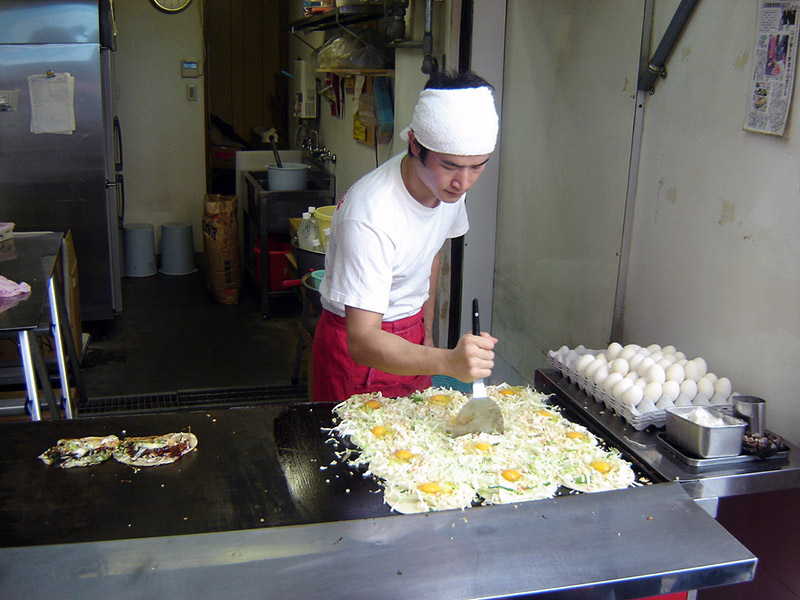
Sometimes you really suck starting out. Follow the easy okonomiyaki recipe above as closely as possible. When you're ready to move on, check out this list of tips from Osaka restaurants. A TV show called wafuu souhonke 和風総本家 interviewed 100 okonomiyaki-ya-san お好み焼き屋さん (okonomiyaki restaurant) owners. Here's the results of the survey.
1. What do you do with the cabbage?
- Finely chop (mijin-giri みじん切り): 58
- Thinly shred (sen-giri 千切り): 35
- Finely chop and thinly shred: 5
-
Cut into chunks (zaku-giri ざく切り): 2 Advice:
- Whatever way you cut the cabbage, leave it in the fridge for about an hour to evaporate the water. You don't want a watery okonomiyaki.
- If you mince it too much, you can't get the crunchiness from the cabbage, so don't make them too small.
2. Secrets of good batter?
None of the restaurant owners wanted to reveal their secrets on this one. However, some said using a dash of milk makes okonomiyaki fluffy and nice. The best ratio is 4 parts okonomiyaki powder, 4 parts dashi water, 1 part milk. So if it's for four people:
- okonomiyaki-ko 200g
- water 200cc
- milk 50cc
3. The balance of cabbage and batter?
The average balance of cabbage and batter is:
- cabbage 128.6g: batter 80.6g (for one serving) 87 chefs said you should mix one serving at a time right before grilling.
4. Most popular ingredients to add to batter?
- cabbage
- flour + dashi-mix water
- minced benishouga
- tenkasu
- egg
5. How do you mix the batter and ingredients?
- Mix to allow air in: 53
- Mix above the grill: 24
- Mix slowly: 6
- Mix little by little: 3
- Mix by moving the bowl: 2
6. Size
The average size is 16.4cm (diameter) and 1.9cm (thickness).
7. Temperature
The average temp is 200°C-ish.
Advice:
- The electric griddle temperature goes down quickly. So don't grill multiple okonomiyaki at the same time or the temperature will drop.
8. What do you do with the pork?
- Put raw strips on top of okonomiyaki: 64
- Fry it separately from okonomiyaki: 27
- Put raw chunks into the batter and mix it together, then fry it: 9 Apparently, many people put the raw strips on top of okonomiyaki while grilling because that way, the pork oil spreads into okonomiyaki and makes it more flavorful.
9. When do you flip and how?
Flip three to four minutes after grilling the back side (when the rim of okonomiyaki turns dry). You shouldn't angle too much with your spatula. When the okonomiyaki is still raw, flip quickly without hesitating. Don't press or spank the okonomiyaki.
10. How many times do you flip?
- twice: 47
- four times: 36
- three times: 12
- once: 5
11. How can you tell when it's ready?
Half lift the okonomiyaki with your spatula. If it keeps its shape, then it's cooked well. If it bends, the inside is too soft and not cooked yet.
12. How do you put mayonnaise on?
There is no average. It depends on the restaurant.
13. How do you cut okonomiyaki?
- Square-block/grid pattern (格子状/koushi-jou): 63
- Like pizza (ピザ状/piza-jou): 30
- Whatever the customer likes (お好みで/okonomide): 7 There is a reason so many people choose square shapes. The middle is the slowest part to cook. If you cut okonomiyaki into a grid and start eating from outside, by the time you eat the middle, it's more likely to be cooked.
When you cut okonomiyaki with spatulas, stand up, keep your upper arms close to your body. Put your weight on the plate/spatulas. Cut quickly. That way, the cut section of each piece will look better.
Hiroshima Style Okonomiyaki Recipe
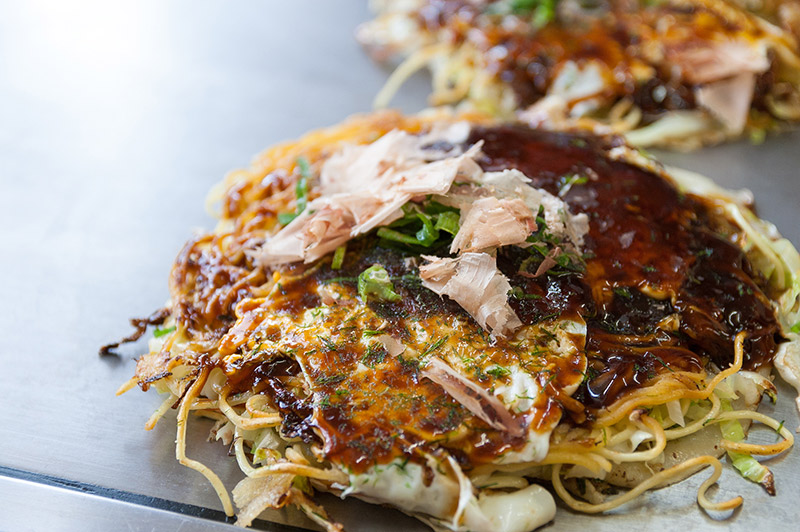
The main difference between the two styles is layering. Hiroshimayaki is layered rather than mixed like Osaka style. If you're ready to get layering, let's move forward. This is much more difficult than Osaka okonomiyaki, actually. Maybe there's a reason why people from Hiroshima look down their noses at Osaka style and call it "mazeyaki" (mix yaki).
This recipe comes from the great Otafuku sauce company. Makes one okonomiyaki pancake.
Ingredients:
- okonomiyaki powder: If not using a pre-made mix, combine
- 20g weak flour
- 30cc dashi-mixed water
- one drop of mirin
- katsuobushi powder: 1g
- tenkasu (fried squid mix adds more flavor): 10g
- cabbage (shredded/sen-giri 千切り): 300g
- green onion (finely chopped/koguchi-giri 小口切り): 5g
- bean sprouts: 30g
- yakisoba noodles: one package (or 150g)
- egg: one egg
- pork belly: 40g (or three strips)
Toppings:
- aonori: some
- Otafuku okonomiyaki sauce: 120g
- Otafuku yakisoba sauce: 20g
Other:
- oil: Preferably sesame oil, but any kind of oil is fine. Preparation:
- Sieve the flour.
- Pour dashi-mixed water in the bowl, then a drop of mirin, and then flour. Mix well with a whisk. If you find a lump, push it into the bowl to crush it.
- After making the batter, leave it in the fridge for a couple hours. It makes the batter stable and it will be easier to pour on the griddle.
- After placing the batter in the fridge, shred the cabbage. The sweetness and hardness of the cabbage will differ depending on the parts. Get rid of the hard center. (Great cabbage cutting tips)
Directions:
- Heat the electric griddle between 160-180℃. (320-356°F).
- Coat the griddle with oil.
- With the ladle, quickly pour the batter in the center of the griddle. Don't use it all. You want 5g left to pour on later. Pour 5 times in a clockwise motion. Then skim the edges to form it. Your ladle should be parallel to the plate. Make the pancake 20cm diameter round. (If you're not sure how to do this technique, this video has a shortcut/cheat).
- Sprinkle katsuobushi powder on top and wait.
- Put cabbage on top. Then tenkasu. Then green onion. Then beansprouts. Finally pork strips. If you pile them too high, it will be tough to flip.
- Pour the rest of the batter evenly.
- When the batter is cooked, flip it with two spatulas. It usually takes only two to three minutes for it to firm up. When it's cooked, it steams evenly and the ridge rises up a bit. It should easily lift with the spatulas. Don't force it, or else you'll rip the batter part. After lifting, move the pancake forward to make space in front of you, then flip it toward you. This requires a wrist snap. Don't hesitate.
- Now it's flipped so the front (meat side) is face down. You want to cook the meat well. If you don't hear sizzling soon after you've flipped, turn up the temperature to 200℃. If the vegetables fall out of the batter, shape it with your spatula. Leave it alone for about 8 minutes.
- When the meat is cooked, you want to steam veggies for a while. If you turned up the temperature, turn it down to 160 to 180℃. Don't press the okonomiyaki. Use your two spatulas to gently push from the sides to make passageways for air.
- When the veggies are steamed, place the noodles on the griddle.
- Put some yakisoba sauce on the noodles. Squirt the number three in kanji 三 with the sauce. Mix the sauce evenly and fry it well. Shape noodles to fit the okonomiyaki but make it a little bit bigger so the okonomiyaki ingredients don't fall off when you flip. Make sure the noodle portion is flat too.
- Lift up the okonomiyaki and put it onto noodles. Lightly press to form a bond between the noodle and the batter.
- Put the egg on the griddle. Crush the yolk with the spatula and quickly put it on the okonomiyaki when half of it is still soft. If it's completely firm, it won't attach well. Don't worry. The rest of the egg should get cooked by steam coming off the okonomiyaki. Flip the egg when you put it on your okonomiyaki. The top side isn't cooked yet.
- When the egg is cooked, flip it over again. Pour okonomiyaki sauce, aonori, and other toppings on. Apparently, okonomiyaki sauce is most delicious at 40℃, so heat it up in the microwave before serving. You may see Hiroshima style okonomiyaki served with benishouga topping. But don't be fooled! People from Hiroshima don't usually put that on top. Then again, okonomiyaki ingredients are suppose to be "okonomi" (your choice), so do what you want.
- Finally, you can eat!
Do Whatever You Like
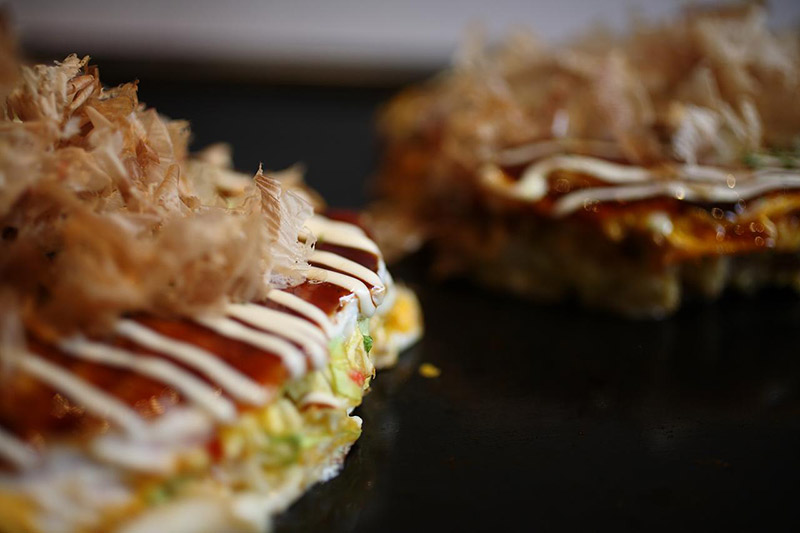
I hope reading this article made you as hungry as I got while writing it (seriously, sifting through okonomiyaki pictures is torture). Hopefully you'll be able to try both styles in Japan and at home. And your new knowledge of okonomiyaki's humble origins should make the experience extra satisfying. Just make sure it tastes exactly the way you want it to taste. Otherwise you'll miss the essence of okonomiyaki.
